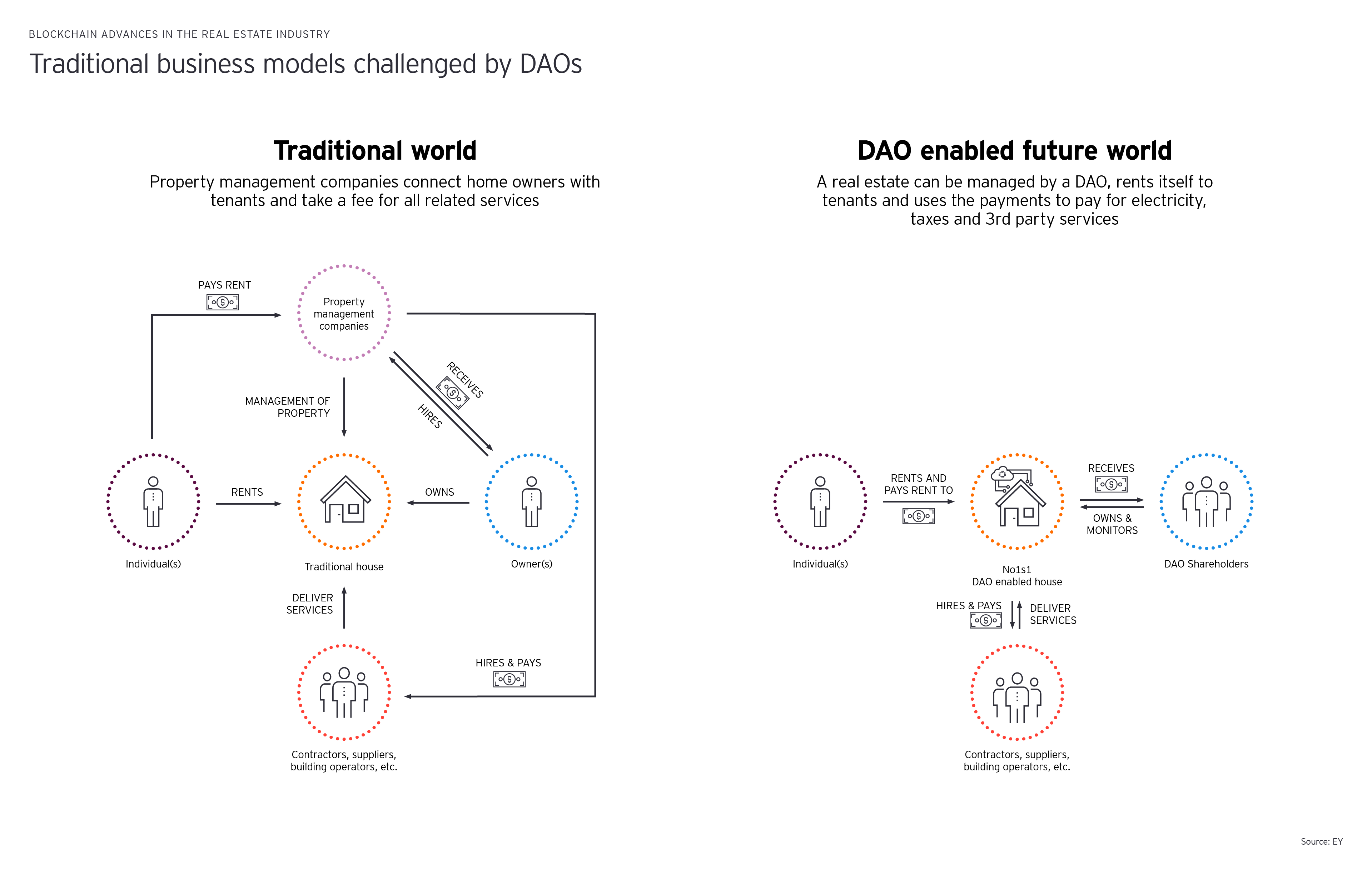«If the future of the built environment is digital, blockchain offers us the opportunity to design new organizational structures that can manage and govern this digital future.» – Daniel Hall, Assistant Professor, Innovation and Industrial Construction, Department of Civil, Environmental and Geometric Engineering, ETH Zurich
What is a DAO and how does it work?
Great question. A DAO is an organizational structure that is represented by rules that are encoded into smart contracts on a blockchain. These smart contracts are fully transparent and controlled by the shareholders in the DAO. Smart contracts define the business logic, while the underlying blockchain acts as a secure digital ledger, enforcing the consensus rules and tracking all interactions in an immutable way.
As computer code-based organizations that are programed to own, build, manage and maintain physical assets, DASs — a specific form of DAOs in the context of real estate — facilitate all aspects from building design to facility management and financial transactions through smart contracts, again leveraging the power of blockchain technology. Humans are still initially involved in the development and programming of the processes implemented in the smart contracts, but after deployment, humans step out, leaving technology to do the work, including the decision-making.

«Blockchain and the Internet of Things will allow objects to participate in our economy. No1s1 explores this with a tangible prototype that many can relate: a self-owning house.» Jens Hunhevicz, PhD Candidate, Scientific Research Assistant and Chair of Innovative and Industrial Construction, Department of Civil, Environmental and Geometric Engineering, ETH Zurich
What would this mean for companies in or related to the construction industry?
I think this is an outermost example of what technology makes possible for construction and the real estate sector. It opens up enormous opportunities for new products, services and business models that leverage blockchain enabled DAOs. Ecosystem participants such as architects, engineers, contractors, building suppliers, facility managers would interact with and be hired by a computer program. The base for interactions would be clear computer-encoded rules in the form of smart contracts, with the exact business requirements suppliers need to meet, including specifications on time, quality, cost and sustainability. Because human-computer interactions such as these are still in their infancy, the exact implications for regulators and industry participants have yet to be explored.
In a recent EY-Parthenon article, we discuss the enormous shifts occurring across the entire construction value chain, largely as a result of rapidly evolving technology. Construction players are already facing increasing pressure to migrate from linear business models to more data-driven circular models and end-to-end digitization. Companies that are already looking to gain a competitive advantage in a digitalized, fast-changing environment can pivot to meet the requirements of DAOs and excel in this new market. Those that would prefer to remain in an analogue world should prepare for new companies to emerge to seize the opportunities DAO models will offer.
You’ve mentioned some of the opportunities for companies along the construction value chain. What are some of the risks?
From a business model perspective, two subsectors that will have to fundamentally reimagine their business models in a self-owned and self-managed construction world are real estate and facility management. Essentially, their positions as intermediaries will vanish. However, new opportunities will arise for companies in these subsectors that embrace the new technology and adapt their product and service portfolios for the autonomous world.
Other risks relate to technology. Smart contracts can be coded in a safe and trustworthy way, provided appropriate governance and control systems are in place. It is common practice to have smart contracts audited prior to deployment. Several specialized business service providers, including EY-Parthenon, have established themselves in this area. EY-Parthenon offers a «EY Smart Contract & Token Review tool», which reviews the underlining code of smart contracts to increase confidence in blockchain-enabled transactions.
Given this reality, DAOs will require accountability, as well as technology impact assessments that consider the ethical implications for DAOs to make the right decisions. Moreover, while algorithms can make autonomous decisions, human-in-the-loop or society-in-the-loop approaches may be needed to apply a human lens to critical aspects of the DAO.
Where does the environment fit in with respect to DAOs?
Great question. Environmental sustainability is a key consideration in construction in general. Consequently, sustainability should apply to DAO models, creating significant opportunities across the construction value chain. This will include creating specifications for a building to embed net-zero and sustainability into the design from the very beginning, as well as full transparency along the life cycle regarding sustainability performance. On the flip side, the significant energy needs to operate certain blockchain applications need to be addressed. Fortunately, there is already a lot of research underway to resolve this challenge.
Although DAOs and autonomous buildings may be a few years away, what should companies across the construction value chain be thinking about now?
Historically, construction players are rather hesitant to embrace digital transformation. As such, there may be an inclination for companies in the industry to take a wait-and-see approach to autonomous buildings. However, if companies don’t start embracing new technologies early on, there are startups and new entrants that will eagerly step in and capture untapped advantages.
As I see it, there are five questions companies across the value chain will want to ask themselves to prepare now for self-owned buildings:
- How do I prioritize my investments to optimize today’s business and prepare for the next and beyond? Because construction companies tend to operate on very thin margins, it can be challenging to think about investing now for an uncertain future. However, investments in transformative technologies offer several opportunities to grow the topline with differentiated services as well as the bottom line with improved operational efficiencies, thus increasing margins that can be invested in the new reality.
- Where will I fit in a DAO future? Architects, engineers, contractors, suppliers and building operators will need to think about how their products and services will interact with a DAO and how business models may need to change to seize growth and efficiency opportunities.
- Who do I need in my ecosystem? Now is a good time for construction companies to review whether they’re collaborating with the right partners and have formed the right alliances. We see a future in which ecosystems will compete against one other rather than single company-to-company competition. The makeup of a company’s ecosystem may also trigger a portfolio review that considers whether to make, buy or partner.
- Do I have the right technology platform to build up-on? Most companies in the construction industry have embarked on some form of digital transformation. Depending on their level of maturity and how far along they are in their journey, some need to accelerate their digital transformation efforts to be ready to absorb new technological structures, such as DAOs.
- Do I have the right skills and capabilities in my organization? Companies will also want to review their current workforce capabilities to determine whether they have the right people with the right skillsets to address the needs of emerging technologies such as blockchain and smart contracts, which underpin organizational structures such as DAOs.
«As our physical, digital and biological worlds continue to converge, there is no better time than now to discuss ownership and governance of the built environment. This is the value I see in the no1s1 project.» - Hongyang Wang, PhD Candidate and Scientific Research Assistant, Innovative and Industrial Construction, Department of Civil, Environmental and Geometric Engineering, ETH Zurich
Summary
I know that the notion of self-owned and self-managed buildings sounds like a radical idea that may never see its day. We once thought that about self-driving cars too. Today, we are on the cusp of witnessing a complete reimagining of mobility. I believe the same will happen with buildings. The good news is that we can learn and transfer experience from the automotive industry to the construction industry. But first, companies across the construction value chain will need to rapidly accelerate their speed of digital transformation before the future is upon them and it is getting late to act.


